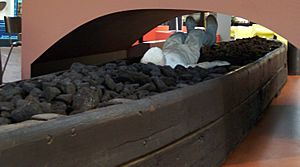Legging (canals) facts for kids
Legging was a special way to move boats through long, dark canal tunnels filled with water. It was very common in the 1700s and early 1800s. This method helped boats travel through tunnels that didn't have a path for horses to walk on.
Contents
What is Legging?
Long ago, many canal tunnels were built without a towpath. A towpath is a path next to the canal where horses would walk to pull boats. Building tunnels with a towpath would have made them much wider and more expensive. Before engines were invented for boats, legging was one of the only ways to get a boat through these tunnels.
How Legging Worked
Usually, two people were needed for legging. They would lie down on a wooden board at the front of the boat. Holding onto the board, they would push their feet against the tunnel walls. This action slowly moved the boat forward.
Legging was a very hard and often dangerous job. Sometimes, special "wing" boards were added to the boat. These made the job a bit safer. At one tunnel called Crimson Hill, some stones in the walls were even carved out. This gave the leggers a better place to push their feet. While the boat was being legged through the tunnel, the horse that usually pulled the boat would be led over the hill above.
Professional Leggers
For short tunnels, the boat's own crew would do the legging. But for very long tunnels, there were professional leggers. These were people whose job was just to push boats through tunnels. Famous places for professional leggers included Blisworth Tunnel and Dudley Tunnel.
At the Standedge Tunnel, which is about 3 miles long, skilled leggers could move an empty boat through in about 1 hour and 20 minutes. A boat full of goods would take about 3 hours. For this hard work, they were paid about 1 shilling and 6 pence. This was a good amount of money back then.
At Blisworth, boatmen were sometimes forced to hire these leggers. So, in 1827, the leggers were officially registered. They were given special brass armbands to show they were approved. At Standedge Tunnel, it eventually became a rule that you had to use the official leggers to pass through.
At Morwellham, some boatmen were said to push against the tunnel roof instead of the walls. This tunnel had a strong flow of water, so moving the boat in one direction was very slow.
The End of Legging
The need for legging began to disappear when tunnels started to be built with towpaths. Berwick Tunnel on the Shrewsbury Canal, opened in 1797, was one of the first tunnels to have a towpath. This meant horses could pull the boats all the way through, and legging was no longer needed.
Legging was also used in the man-made tunnels (called adits) of Speedwell Cavern. Miners used this method until the boats got electric motors. Sometimes, a guide in the cave will still show how they used to push the boat by hand against the cave roof.
Canal Tunnels Where Legging Was Used
Here are some of the canal tunnels in England where legging was known to be used:
- Blisworth Tunnel
- Braunston Tunnel
- Butterley Tunnel
- Dudley Tunnel
- Greywell Tunnel
- Harecastle Tunnels (especially the older one by James Brindley)
- Islington Tunnel
- Lapal Tunnel
- Maida Hill Tunnel
- Morwell Down Tunnel
- Norwood Tunnel
- Sapperton Canal Tunnel
- Standedge Tunnel
- Worsley Navigable Levels
Images for kids



